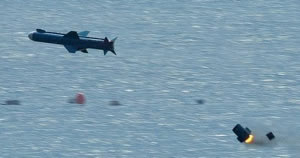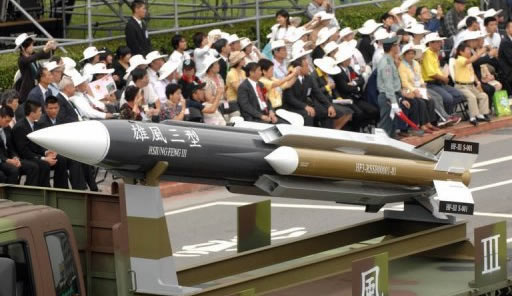

A report in The Liberty Times newspaper in Taipei claims that the Defense Ministry has deployed cruise missiles in positions capable of reaching key military installations along the southeast coast of the Chinese mainland. According to the news report, the Taiwanese-built “Hsiungfeng” (Brave Wind) IIE (HF-IIE) has a range of approximately 600 to 650 kilometers and entered low-rate production in 2005 with a mobile-launch version entering production in 2008. Full-volume production is reported to have started in 2011 with a goal of producing approximately 500 missiles.
Taiwan currently has three versions of the HF-II in service, ship-based, air-launched, and the land-based/mobile-launched HF-IIE. The ship-based version was scheduled for replacement with RGM-84 Harpoons, but the funding for this was eventually cancelled. The HF-III, a next-generation supersonic surface-to-surface missile, has been developed and is expected to enter production soon while development of the HF-II series continues.
Sources claim that the HF-IIE is not an enhanced version of the HF-II anti-ship missile, but is instead a completely new design with a striking resemblance to the US Tomahawk cruise missile. It is basically a weapon designed to strike high-value land-based targets like air defense positions, communications facilities, and command-and-control assets. Due to its relatively small warhead and the limited number of missiles procured seems to indicate that the HF-IIE was never intended as a “first strike” weapon.
The HF-IIE Block I missile carries a 200-kilogram warhead and is equipped with inertial navigation, GPS, and terrain-identity upgrades. It travels at high subsonic speed and uses an Imaging Infrared IIR and autonomous digital target recognition system for target acquisition and to optimize point-of-aim on final approach. The HF-IIE program is believed to have cost about $1.02 billion.
This missile deployment represents the first time Taiwan has positioned cruise missiles aimed at China. It is believed that as many as 100 missiles have been deployed while defense analysts estimate that China has as many as 1,600 missiles of various types targeted on Taiwan.
Taiwan’s Ministry of Defense has so far declined to comment on the reports.
In related news, a Taiwanese legislative committee approved a proposal to arm the Navy’s newest fast-attack missile boats, now being developed, with the HF-IIE missiles. The new Hsun Hai (“Swift Sea”) fast-attack missile boat project is expected to produce corvettes of 450 tons capable of launching retaliatory strikes against Chinese targets

should armed conflict ever arise. Chinese Nationalist Party (KMT) legislator Lin Yu-fang stated that arming the new corvettes with HF-IIE missiles would provide the Navy with an improved capability of stealthy and unpredictable strikes from the sea. Chan Shih-chang, Deputy Minister of National Defense, told the committee that the proposal would receive detailed evaluation.
As for the HS III, Taiwan is also planning to equip its eight 3,000-ton Chengkung-class (PERRY Class) frigates with this supersonic anti-ship missile. The military has earmarked about US$400 million to produce 120 such missiles, completing the equipment of the six remaining frigates and twelve missile boats.
Each of the frigates will carry four HS III in addition to the four HS II missiles currently on board. Taiwan is also introducing the supersonic HS III In addition, twelve 580 ton 12 Chinchiang-class missile patrol boats are also been equipped with four HS III missiles each. HS III is considered as Taiwan’s ‘carrier killer’ weapon, designed to counter the growing threat of Chinese seapower and especially the aircraft carriers China plans to field later in this decade. The missile has an effective range of 130 km.
Two of the Taiwanese frigates have already been fitted with container-launchers modified to carry the new missile. For the foreseeable future these frigates will maintain both weapons on board, gaining the capability to engage targets with multiple, coordinated attacks. Moreover, the HS-IIE will offer engagement at significantly longer distances, possibly cooperating with missile boats to be configured to carry either HS II or HS III, deployed to forward positions.
Speed is the main advantage of this new antiship missile, as it dramatically reduces the reaction time available to the target. Supersonic missiles are not common with today’s navies. Only the Russian and Indian Navy currently have Mach 2 anti-ship missiles in their inventory. The typical reaction time against high-subsonic anti-ship (Mach 0.85) missile like the Harpoon or Exocet, when it is detected by the target vessel’s onboard radar, is about 2 minutes. An HF-3 missile, flying at just above Mach 2 at comparable sea-skimming altitude during the attack phase could cover the same distance in less than 50 seconds.

















